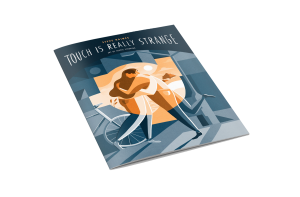
Why can’t we tickle ourselves? How can slow touch convey more powerful emotions than fast touch? How does touch shape our perception of the world? In this short interview, Steve Haines – author of Singing Dragon’s best-selling Really Strange series – discusses the inspiration behind his new book, Touch is Really Strange.
When did you start working on the book?
The idea for a book on touch has been around since 2019, but this was definitely a lockdown project. The Really Strange series has been huge fun and continues to get heart-warming feedback. There have been suggestions for books on Depression, Adverse Childhood Experiences, Grief or Breath.
Whilst I have some experience with clients with all those topics, I realised I have far more to say about touch. I use touch everyday in normal work life and teach 2-year courses on being skilful with touch.
What inspired the topic?
In my career I have undergone a paradigm shift in how I understand touch.
With massage, shiatsu and chiropractic I often used strong, quick interventions; poking, prodding, stretching, manipulating. The goal was freeing up structural issues. It was fun, but did not work so well with trauma, persistent pain and anxiety.
I now use touch as tool primarily to convey feelings of safety, to support emotional expression and to improve a sense of embodied connection.
Touch Is Really Strange is a celebration of slow, gentle, meditative touch – ‘relational touch’. Touch that is focused on the whole person and all their stories. Touch where the goal is to connect to feelings that are often hidden, rarely simple and sometimes scary.

How did you collaborate with Sophie?
This is my 4th book with Sophie. I still do not quite understand how she can produce such clear representations of complex ideas so quickly.
Typically I write chunks of 3 or 4 pages developing an argument, sometimes, but not often, with suggestion for images. Within a few days she invariably rocks back with a set of wonderful drawings. Its always exciting waiting to see what appears in my inbox.
The art and colours are all Sophie. In this book she has changed the look a little, the colours are simpler and the style has developed. I love what she has done.
Why is it extremely timely?
Lockdown has been a massive experiment in non-touching. The stories of people isolated in hospital with only a screen to communicate to loved ones or the images of people on either side of plastic barriers are heart-breaking.
There are now frequent newspaper articles on the power of touch – that is very new. Lockdown has reinforced the value of touch as ‘social glue’. Casual contacts are essential to our health and help us feel real.
There is great science on the benefits of touch. We need touch as babies and children to thrive, we ache for touch as adults, and we fare much worse when we are elderly without touch.

What do you hope readers can take away from it?
We can usefully classify two types of touch – quick touch and slow touch. I want people to appreciate that slow touch can communicate powerful emotions. The book reviews the science of ‘interoception’, a kind of slow ‘inward touch’, and shows that touch, done well, can be a huge gift to support potent shifts in our physiology and our sense of wellbeing.
It also offers that all early learning is mediated by meeting a world that pushed back as we explored and moved. We touch the world and the world touches back, not always gently. We learn, and can relearn, safety through processes of touch and being touched.
There are four practical exercises at the end of the book that I hope will help people reframe what is possible when we touch.
Touch is Really Strange is aimed as much at bodyworkers as at anybody interested in touch, and the power of touch.
Pre-order your copy of Touch is Really Strange now
 Touch is Really Strange
Touch is Really Strange
Steve Haines, art by Sophie Standing
Touch helps us feel real. Knowledge comes through our body as we engage with space and with others. Before we have language, our concepts are formed as we meet a world full of edges and textures. Touch is Really Strange celebrates the power of inward touch (interoception) and looks at how we can use skilful contact to promote feelings of joy, connection and vitality.
Published on 21/04/2021 and available from the Singing Dragon website.
Or click here to pre-order now.